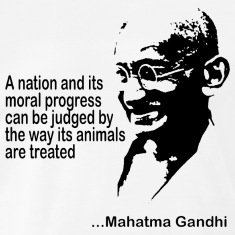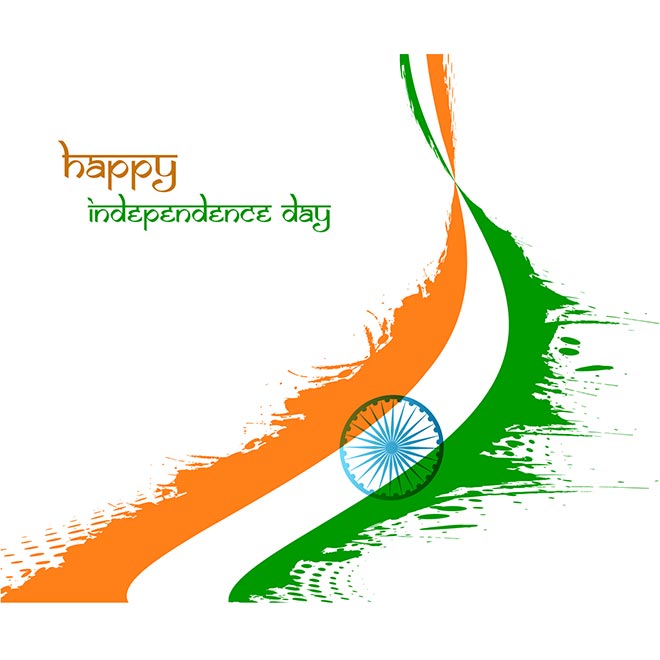
The Veterinary Council of India (VCI) is the premier statutory body within the veterinary domain in India under the provision of the Indian Veterinary Council Act (1984). The Act also has a provision ( Section 32 ) for State Veterinary Councils (SVCs). The mandate of VCI and SVC’s is to regulate the veterinary practice and to ensure uniform standards of veterinary education in India. The Indian Veterinary Council Act has jurisdiction all over the country. A State within the Indian union adopts this Act by resolution in its legislative assembly passed in pursuance of clause (1) of Article 252 of the Indian Constitution.
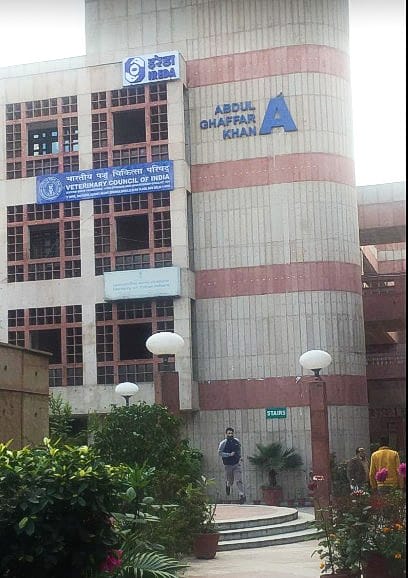
Office of the Veterinary Council of India (VCI ) at August Kranti Bhawan, Bhikaji Cama Place, New Delhi ( Photo credit: Rajesh Panse )

Office of the Mizoram State Veterinary Council ( Photo credit: MSVC publication )
The VCI is currently operating from a location in the national capital in an area of 361 sq meters taken on lease from Housing and Urban Development Corporation. VCI has sought more space to expand its activities. During the year 2016, The Union Cabinet, chaired by Prime Minister Narendra Modi, has approved the proposal for transfer of two acres of land from the Indian Agricultural Research Institute (IARI), New Delhi, to the VCI on lease basis for 99 years. ( Source: News Update of office of Prime Minister of India )
However, the VCI has not been fully functional since 2016 due to a long-standing legal dispute. A legal petition challenged the non-declaration of the result of the election of Vice President of VCI held in April 2017. The same petition also challenged government notification dated 12th January 2018 for conducting the fresh election of President and Vice President of the Council after the expiry of the term of elected members ( without conducting fresh election ) and inviting only nominated and ex-officio members to participate. The honorable Delhi High Court subsequently stayed the election of President and Vice President of the Council scheduled on 19th January 2018. Public interest litigation (PIL) dated 20th May 2019 filed at High Court of Punjab and Haryana by Pashu Chikitsak Mahasangh – an organization of veterinarians indicated that there is only limited instance of conduct of mandatory council meetings during last few years. The fresh election to the council is due since May 2017. The PIL also mentioned that as per provisions of section 11(1) of the IVC Act. 1984, the post of Secretary of Council is statutory post, and he/she should be Council’s employee as per provisions of the IVC Act and Regulations framed thereunder. However, since September 2016 onwards, a central government employee is looking after duties Secretary of the Council as an additional Charge. The judgment on the PIL is still pending. Various reports indicate that many SVC’s too, have also not been active for long, mostly due to lack of election/nomination of members against vacant positions.
The Government of India, in recent months, has taken steps to initiate a process of election and nomination of new members for the VCI as directed by Delhi High Court ( Judgement dated 10th October 2019 ). The government has amended VCI election rules ( Notification dated 29th November 2019, Published in Gazette of India dated 2nd December 2019 ) to introduce online voting. Newspaper and social media advertisements are being made for veterinarians across the country to update their registration with their mobile numbers and email addresses. The election and nomination process, if implemented smoothly, is likely to trigger efforts within various states to strengthen the functioning of their respective SVC’s.
The OIE-PVS ( The World Organization for Animal Health -Performance of Veterinary Services ) evaluation mission report of India published in 2018, highlighted inadequate autonomy as a crucial organizational weakness of the VCI and SVC’s in the context of international standards ( Refer evaluation of Veterinary Statutory Body, Article 3.2.12 of Terrestrial Animal Health Code 2019). According to the report, the inadequate autonomy was due to the fact the central government nominates fourteen (14 ) of the twenty-seven (27) members of the VCI and only 11 numbers are elected members from amongst registered veterinarians. The appointed Secretary of the Council and Animal Husbandry Commissioner, Government of India, is an ex-officio member of the Council. The Act and current rules and regulations do not guide the composition of a quorum. Currently, the quorum for a VCI meeting is nine (9) members, all of whom may be ‘nominated members’. Similarly, SVCs have four (4 ) nominated members, and four ( 4 ) elected members and three (3) ex-officio members; thus, a bias exists in favor of the central government and state institutions in both the VCI and SVCs. There is no provision to ensure representation from the private or other non-government sectors.
According to the PVS report, another critical aspect affecting autonomy is the fact that both the center and state statutory bodies derive the majority of their funding from grants provided by the central and state government.
The other organizational weakness highlighted in the report include inadequate resources to perform the mandated functions effectively, the lack of an updated register of veterinary practitioners reflecting essential details such as nature of employment and updated practice regulations (e.g., absence of multi-state registration of Veterinarians), uniform provision for training and supervision of veterinary para-professionals, etc. The report also indicated that SVC’s were rarely taking disciplinary action, and no consolidated reports on disciplinary actions were available.
The OIE PVS report provided the following recommendations focusing on organizational strengthening of the Veterinary Statutory Body:
- Ensure that the VCI is more representative and receives increased funding directly from the registration of veterinarians and other assessment and licensing activities.
- Undertake a rigorous review of professional ethics and disciplinary issues and hold more frequent disciplinary hearings, as necessary; reports and annual summaries should be made publicly available.
- Establish the capacity within the VCI, or an alternative body, for the regulation of veterinary para-professionals.
The report did not elaborate in detail the ways to make the VCI / SVCs more representative. A review of the current composition of VCI /SVC is needed to ensure that councils get members from all categories of veterinarians classified based on their employment, e.g., public veterinarian, public and private academicians, veterinarians in armed forces ( including Central Armed Police Forces ), private practicing veterinarians, and veterinarians associated with the industry, cooperative, research, NGOs, and other specialized groups.
The dependency of a statutory body on government funding prohibits the development of full autonomy, and the report pointed out the need for VCI and SVCs to generate more revenue from the registration of veterinarians and other assessment and licensing activities. The government, where justified, should only grant periodic assistance required for significant infrastructure investment. The development of a regular paid needs-based Continuous Veterinary Medical Education (CVME) program in joint association with national and international partners is another area that should support revenue generation. Revenue generation through CVME can be boosted with the introduction of a mandatory CVME requirement for the renewal of registration.
The second recommendation related to the need for rigorous enforcement of regulations and transparency to support improved service standards and ensure the much needed organizational visibility to VCI’s and SVCs. For transparency, VCI / SVC needs to act proactively and ensure compliance with adopted standards, code of professional conduct, and regulations. The VCI / SVC should support a periodic independent evaluation of compliance status.
The third recommendation focused on the regulation of veterinary paraprofessionals ( education and service ) under VCI / SVC’s that can usher in a new era of professional development within the veterinary domain in India. It will further widen the responsibility of VCI / SVCs and the justification of public investment thereof for internal capacity development. The efforts towards standardization of education/training and strengthening of veterinary para-professionals have become a sensitive issue in India. There is a perception that para-veterinarians will replace the services of veterinarians in front end service delivery and therefore, regulatory mechanisms need to be in place to clearly identify the prerogatives of both veterinarians and veterinary paraprofessionals and the reporting relationships between the two groups. Veterinary Service (VS) is regulated as it impacts public health and animal welfare. India, with its growing international trade and commitment to issues such as transparent disease reporting, antimicrobial resistance, etc., cannot afford a para-veterinary service, which is delivered by unskilled persons and is not regulated appropriately.
Besides the above recommendations, a more significant role of VCI /SVCs in conducting a needs assessment for Continuing Education (CE) and then overseeing the delivery of the required programmes with licensing of private training providers, designing, and delivery of CE program will go a long way in supporting organizational strengthening. The PVS report suggested VCI should ensure the legal provision and make CE credit mandatory for the renewal of registration.
Investment in internal capacity building for the development of systems needed for continuous veterinary workforce assessment, and related research to understand the changing ‘day one competency’ requirements of veterinarians and veterinary paraprofessionals is another vital area where VCI should invest soon for organizational strengthening. In this connection, VCI should enter into collaboration with international organizations, and Veterinary Statutory Body (VSBs) of different countries.
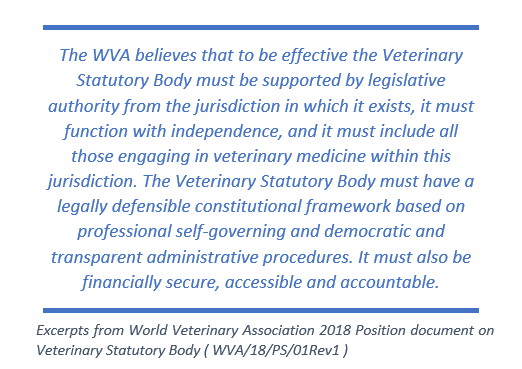
Veterinary Statutory Bodies provide the foundation for a robust independent veterinary service in compliance with the international standards (as laid down in the OIE Terrestrial Animal Health Code). In India, the VCI and SVC provide a strong platform for compliance with these international standards, but some shortcomings remain. As indicated in this article, by addressing a few key issues India can improve Veterinary Services through better regulation and training of the veterinary workforce, achieve full compliance with international standards and support its trade in animals and animal products.
Citation:
Barbaruah Miftahul, Weaver John, “Organizational Strengthening of Veterinary Council of India and State Veterinary Councils with particular reference to the recommendation from OIE-India PVS report (2018 )”, The Vet Helpline E-magazine, Category: Veterinary Profession and Continuing Education, Vol VIII (2020) ISSN 2454-9282
References:
(1) Indian Veterinary Council Act 1984
(2) Case No.CWP-PIL-39-2019 ( Diary No. 2207704 ) Pashu Chikitsak Mahasangh vs Union of India and Others, High Court of Punjab and Haryana ( Case progress accessible at https://www.phhc.gov.in/ )
(3) Notification dated 29th November 2019, Published in Gazette of India dated 2nd December 2019
(4) Dr. Ravinder Chaudary and Anr. Vs.the Veterinary Council of India and Anr. – Court Judgment https://www.legalcrystal.com/case/1225863/dr-ravinder-chaudary-vs-veterinary-council ( Dated dated 10th October 2019 )
(5) OIE -PVS India Report 2018
(6) Evaluation of Veterinary Statutory Body, Article 3.2.12 of Terrestrial Animal Health Code 2019 (Can be accessed at https://www.oie.int/index.php?id=169&L=0&htmfile=chapitre_eval_vet_serv.htm)
(7) World Veterinary Association 2018 position document on Veterinary Statutory Body ( can be accessed from http://www.worldvet.org/about.php?sp=papers )
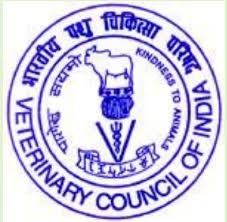
Click Here to Visit the website of Veterinary Council of India

